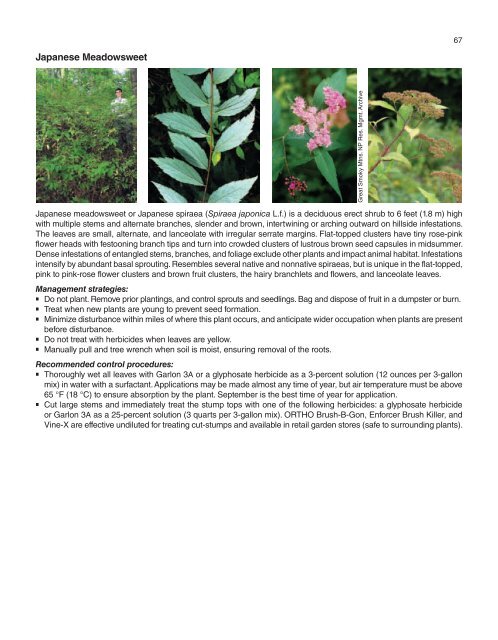A Management Guide for Invasive Plants in Southern Forests James ...
A Management Guide for Invasive Plants in Southern Forests James ...
A Management Guide for Invasive Plants in Southern Forests James ...
- No tags were found...
You also want an ePaper? Increase the reach of your titles
YUMPU automatically turns print PDFs into web optimized ePapers that Google loves.
67Japanese MeadowsweetGreat Smoky Mtns. NP Res. Mgmt. ArchiveJapanese meadowsweet or Japanese spiraea (Spiraea japonica L.f.) is a deciduous erect shrub to 6 feet (1.8 m) highwith multiple stems and alternate branches, slender and brown, <strong>in</strong>tertw<strong>in</strong><strong>in</strong>g or arch<strong>in</strong>g outward on hillside <strong>in</strong>festations.The leaves are small, alternate, and lanceolate with irregular serrate marg<strong>in</strong>s. Flat-topped clusters have t<strong>in</strong>y rose-p<strong>in</strong>kflower heads with festoon<strong>in</strong>g branch tips and turn <strong>in</strong>to crowded clusters of lustrous brown seed capsules <strong>in</strong> midsummer.Dense <strong>in</strong>festations of entangled stems, branches, and foliage exclude other plants and impact animal habitat. Infestations<strong>in</strong>tensify by abundant basal sprout<strong>in</strong>g. Resembles several native and nonnative spiraeas, but is unique <strong>in</strong> the flat-topped,p<strong>in</strong>k to p<strong>in</strong>k-rose flower clusters and brown fruit clusters, the hairy branchlets and flowers, and lanceolate leaves.<strong>Management</strong> strategies:Do not plant. Remove prior plant<strong>in</strong>gs, and control sprouts and seedl<strong>in</strong>gs. Bag and dispose of fruit <strong>in</strong> a dumpster or burn.Treat when new plants are young to prevent seed <strong>for</strong>mation.M<strong>in</strong>imize disturbance with<strong>in</strong> miles of where this plant occurs, and anticipate wider occupation when plants are presentbe<strong>for</strong>e disturbance.Do not treat with herbicides when leaves are yellow.Manually pull and tree wrench when soil is moist, ensur<strong>in</strong>g removal of the roots.Recommended control procedures:Thoroughly wet all leaves with Garlon 3A or a glyphosate herbicide as a 3-percent solution (12 ounces per 3-gallonmix) <strong>in</strong> water with a surfactant. Applications may be made almost any time of year, but air temperature must be above65 °F (18 °C) to ensure absorption by the plant. September is the best time of year <strong>for</strong> application.Cut large stems and immediately treat the stump tops with one of the follow<strong>in</strong>g herbicides: a glyphosate herbicideor Garlon 3A as a 25-percent solution (3 quarts per 3-gallon mix). ORTHO Brush-B-Gon, En<strong>for</strong>cer Brush Killer, andV<strong>in</strong>e-X are effective undiluted <strong>for</strong> treat<strong>in</strong>g cut-stumps and available <strong>in</strong> retail garden stores (safe to surround<strong>in</strong>g plants).
















